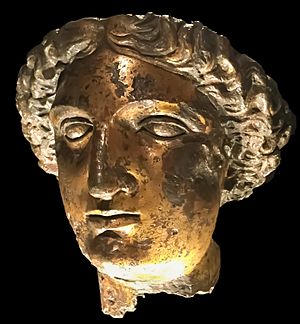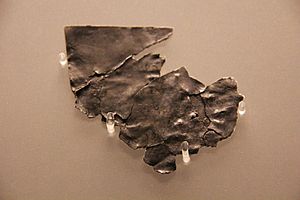Bath curse tablets facts for kids
The Bath curse tablets are a collection of about 130 ancient Roman "curse tablets." These tablets were found in 1979 and 1980 in the city of Bath, England. People wrote on these tablets to ask the goddess Sulis Minerva for help. They wanted her to return stolen items and to cause trouble for the thieves.
Most of the tablets are written in British Latin, which was the everyday language spoken by people in Roman Britain. These tablets help us understand how people lived and spoke between the 2nd and 4th centuries AD. UNESCO has even recognized them as important historical items. They are part of the Memory of the World UK Register.
Contents
Finding the Tablets
The Roman baths and a temple for the goddess Sulis Minerva are in Bath, England. The Romans called this city Aquae Sulis. Experts like Barry Cunliffe and Peter Davenport dug up these sites between 1978 and 1983.
In 1979 and 1980, about 130 tablets were found. They were discovered in a special area called the "Sacred Spring" under the King's Bath. Workers removed a concrete floor and walls to find them. This digging revealed many Roman items, including the tablets. These discoveries show how important Sulis Minerva was to the people living there.
The tablets are small and rectangular. Some were broken into pieces. At first, people thought they were made of lead. But later tests showed they were made of lead mixed with tin. Some even had small amounts of copper. Some tablets were pressed very thin and smooth, like paper. Others looked like they were roughly hammered from a lump of metal.
Most tablets had writing on them. Some used capital letters, while others used flowing script. The writing skill varied a lot. Some tablets had marks that looked like someone who couldn't write was trying to copy letters. For example, they had repeated lines of crosses or sevens. Some tablets were completely blank.
A historian named Roger Tomlin published all the inscriptions in 1988. You can see the tablets today at the Roman Baths Museum in Bath.
How They Were Made and Used
These tablets are known as "curse tablets." They were made between the 2nd and 4th centuries AD. Curse tablets are metal sheets with curses written on them. These curses were usually against people who had stolen small things. People used them to ask gods for help in getting justice. This practice was popular all over the Roman world.
The Bath curse tablets were specifically addressed to the goddess Sulis. People believed she had the power to find the thief and make them face consequences. Writing on these tablets was part of a special ritual. It was called a "prayer for justice" to the goddess. This ritual combined elements of magic and religion.
The main goal of the prayer was not just to punish the thief. It was more like a strong warning. The thief would face trouble if they did not return the stolen items. For the curse to work, the victim first had to "give" the stolen item to the goddess. This made it seem like the thief had stolen from Sulis herself.
Specialists likely created many of these inscriptions. However, there is also proof that regular people tried to make them too. The process usually involved four steps. Each step was important for the curse to supposedly work.
First, the curse text was written down. This made sure the words fit on the tablet. Second, the tablet itself was made using special tools. Third, the text was carved onto the tablet. Many different handwriting styles were used. Sometimes, fancy details were added. This makes people wonder about the role of the scribes. Some tablets might have been made by people who couldn't write well. But they still trusted that the goddess would understand their marks. The final step was placing the tablet in the right spot. This depended on which god was being asked for help. For the Bath curse tablets, they were placed in the sacred spring at Sulis's temple.
What the Tablets Say
The Language Used
Most of the writings are in everyday Latin. This specific type of Latin is called "British Latin." It was spoken by the Romano-British people. Two of the writings are not in Latin. They use Roman letters, but the language might be an ancient British Celtic language. If this is true, they would be the only examples of a written ancient British Celtic language. However, experts are still discussing what they mean.
What the Curses Are About
Almost all of the 130 Bath curse tablets are about getting stolen items back. They are a type of curse tablet called "prayers for justice." The stolen items were usually personal things taken from the baths. These included jewelry, valuable stones, money, household items, and especially clothes.
Stealing from public baths was a common problem in Roman times. It was even a well-known joke in Roman stories. Strict laws were in place to punish thieves. Most people who placed these tablets (the victims) seemed to be from the lower social classes.
The writings usually follow a similar pattern. This suggests they might have come from a guide book. First, the stolen item is declared as belonging to the goddess. This makes the loss the goddess's problem. Then, the suspected thief is named. In 21 cases, the victim is also named. The victim then asks the goddess to cause trouble for the thief. This trouble was meant to make the thief return the stolen items. Once made, the victims placed the tablets in the spring that was sacred to Sulis Minerva.
Examples of Curses
The Bath Curse Tablets have different texts, but they all have a similar goal. Some ask the goddess to cause serious harm to the thief. Others seek different ways to get justice. Here is a common example:
-
- Solinus to the goddess Sulis Minerva. I give to your divinity and majesty [my] bathing tunic and cloak. Do not allow sleep or health to him who has done me wrong, whether man or woman or whether slave or free unless he reveals himself and brings those goods to your temple.
The phrase "whether man or woman or whether slave or free" is very common. The next example is unusual in two ways. First, it adds "whether pagan or Christian." Second, the text was written backward:
-
- Whether pagan or Christian, whether man or woman, whether boy or girl, whether slave or free whoever has stolen from me, Annianus [son of] Matutina (?), six silver coins from my purse, you, Lady Goddess, are to get [them] from him. If through some trick he has given me...and do not give thus to him but make him suffer if he has caused trouble for me.
Many tablets name the suspected thieves:
-
- I have given to the goddess Sulis the six silver coins which I have lost. It is for the goddess to get [them] from the names written below: Senicianus and Saturninus and Anniola.
Some writings are very specific about the problems they want the thief to face. They show how angry the victims were:
-
- "Docimedis has lost two gloves and asks that the thief responsible should become confused and unable to see clearly in the goddess' temple."
- "May he who carried off Vilbia from me become weak as the water. May she who took her away become unable to speak."
- "...so long as someone, whether slave or free, keeps quiet or knows anything about it, he may suffer in (his) body, and eyes and every limb and even feel very sick if he has stolen the ring or helped with the theft."
One of the suspected British Celtic writings has been translated as:
-
- The affixed – Deuina, Deieda, Andagin, (and) Uindiorix – I have bound.
Another possible translation of the same writing is:
-
- May I, Windiorix for/at Cuamena defeat (or summon to justice) the worthless woman, oh divine Deieda.
Why They Are Important
The Bath curse tablets are a very important source of information about Roman-British religion. They are especially helpful for showing us the everyday Latin spoken by people. Since they were published in 1988, the Bath writings have been used to understand the nature of British Latin. Also, what the writings say helps us learn about how people thought about crime and justice back then.
In 2014, UNESCO recognized the Bath curse tablets. They are now part of the Memory of the World UK Register.
See also
- Vindolanda tablets
- Larzac tablet
- Ring of Silvianus








